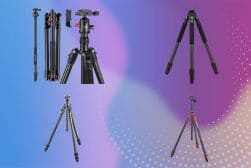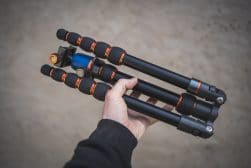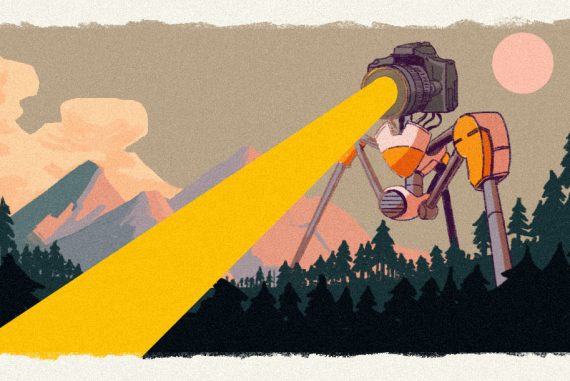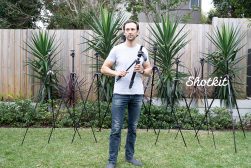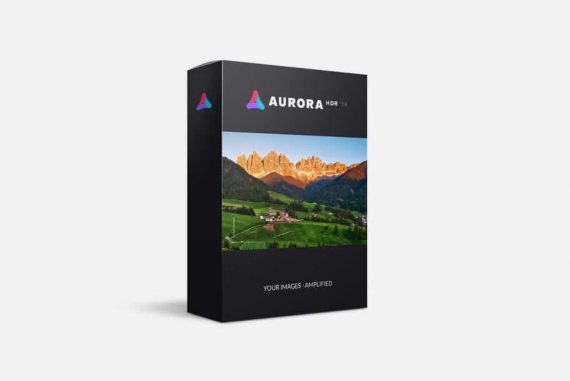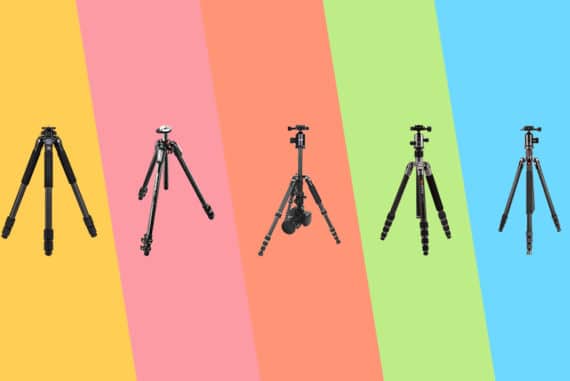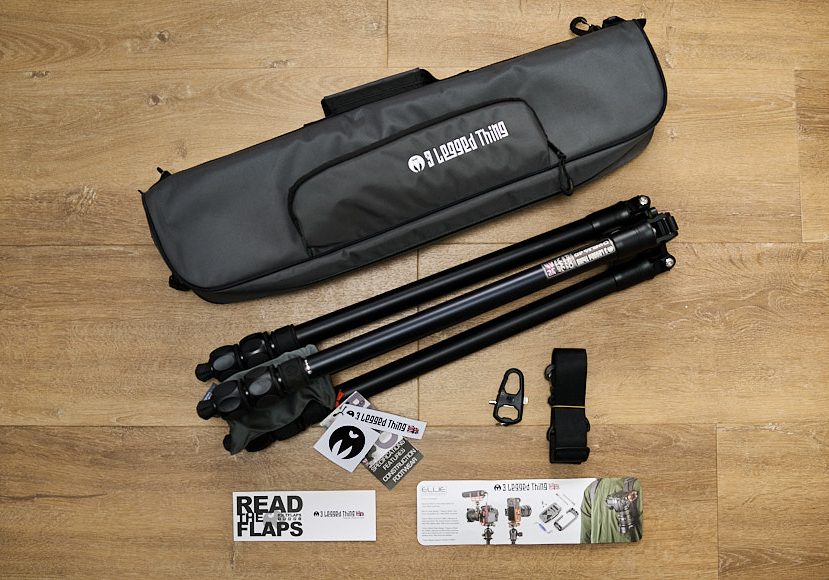
3 Legged Thing Charles 2.0 Heavy Duty Tripod Review
Need a lightweight travel tripod? Look elsewhere! This is a robust, well-designed heavy duty tripod strong enough to support larger cameras and lenses.
10 years ago, 3 Legged Thing were barely known in photography circles. Today, they’re one of the biggest names in tripods. Most successes in business aren’t by accident; it comes from a combination of quality products and hard work.
For those who don’t know the brand, 3 Legged Thing is a tripod manufacturer based out of Bedfordshire, United Kingdom.
They were founded with a unique approach of adding colors to tripods and naming each model after famous people, rather than the industry standard where the name included number combinations like the number of legs, segments, or series.
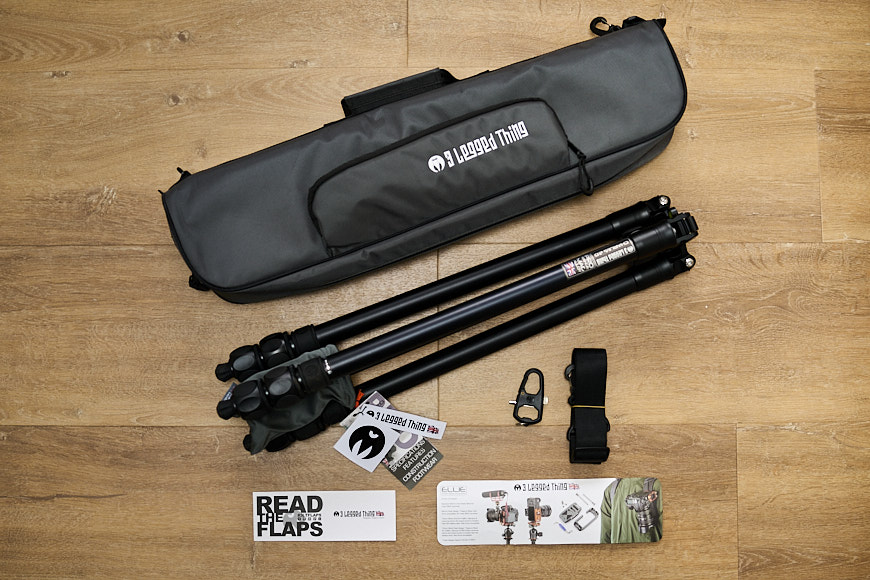
Strong, rugged and stable - everything you need in a great-looking design.
I’ve previously mentioned in reviews that I‘m a fan of companies that try to do something different, and 3 Legged Thing is a company doing that.
Bright colors might not be everyone’s cup of tea, but it adds personality to the brand and in a world where everyone is different, different is good.
We can’t have innovation without people trying things that are different.
The Charles 2.0 is the tripod we’re reviewing today, a tripod in their range that has a heavy-duty load capacity of 40kg. Unlike many of the tripods in their range, this tripod isn’t carbon fibre.
“Designed with landscape, astrophotography and studio photography in mind”
This may seem unusual in the modern age, but the Charles 2.0 is not a travel tripod, and thus, weight is not one of the primary constraints.
When shooting landscape, astrophotography, and studio work, your primary constraint is stability; everything else comes second to that.
I was fortunate enough to receive the Charles 2.0 pre-release for this review, but from what I understand, the product supplied should be identical to the final product.
Table of Contents
3 Legged Thing Charles 2.0 Specs
- Robust – Built like a tank
- Stability – This isn’t going anywhere
- Height – A true full-height tripod without compromising stability
- Versatility – Legs removable to make monopod and/or light stand
- Weight – this isn’t a lightweight travel tripod
- Magnesium Alloy – It can still corrode if exposed to seawater. Cleaning after use will prevent this.
- Max Height 1.85m / 72.8” (1.94m / 76.3” with AirHed Pro)
- Max Height w/o column 1.41m / 55.5” (1.49m / 58.6” with AirHed Pro)
- Min Height 14.6cm / 5.7” (23.1cm / 9.09” with AirHed Pro)
- Max Monopod Height 1.93m / 75.9” (1.44m / 56.6” with AirHed Pro)
- Folded Length 61.2cm / 24”
- Load Capacity 40kg / 88lb
- Tripod Weight 2.12kg / 4.46lb (2.44kg / 5.37lb with AirHed Pro)
- Leg Angles 23º, 55º, 80º
- Sections (Legs/Column) 3 / 1
Build Quality

The Winston is provided with an arca-compatible plate and a spirit level on the ball head.
As an established brand, our expectations tend to be higher when it comes to build quality, and 3 Legged Thing Charles 2.0 doesn’t disappoint in this respect. It’s refined and complete in every respect.
Starting with the first impressions, inside the box, you’ll find the tripod stored inside a good-quality bag. Often bags feel like an afterthought; something included only so they can be mentioned in the specifications. In contrast, this is a high-quality addition that feels like it will last a lifetime. It’s padded to protect the tripod from knocks and thick enough to ensure it won’t tear.
Inside the side pocket, you will find a tripod adjustment multitool with a carabiner that is attachable to the tripod as opposed to a hex key, along with a pamphlet that includes information on the variety of additional footwear options like spikes and ABS balls.
The Charles 2.0 doesn’t include these spikes, which I don’t mind as not everyone needs spikes. 3 Legged Thing provide various options for spikes with either Stilettoz spikes, or Vanz dual ball and spikes.
There is the obvious shoulder strap for the bag, a welcome addition to the size and weight of the Charles 2.0, as I don’t think many will want to carry it by hand for extended periods.
The quality of the Charles 2.0 is impressive. The build quality can be described as solid, built like a tank. This could double as a self-defence weapon, and the tripod would likely come out unscathed.
Many modern metal tripods tend towards the budget range, but this certainly isn’t budget quality. This tripod is Magnesium Alloy which is the same material used in many aerospace applications, like helicopter gearboxes and drivetrains. Whilst it isn’t as costly and lightweight as carbon fibre, it’s stronger and lighter than aluminium.
It’s also important to note that Magnesium alloy is a better option than carbon fibre, given the versatility of the tripod for use as a light boom. A carbon fibre option is likely to bend, whilst Magnesium Alloy is more rigid for this use case.
I like some of the small touches included with the 3 Legged Thing Charles 2.0. The tripod AirHed ball head is covered by a small bag to protect it from scratches when the legs are folded over the head. It’s something really simple, but it is something I wish all tripod manufacturers did with reverse-folding legs. Whilst tripods are tools, nobody wants them scratched unnecessarily.
Size & Handling
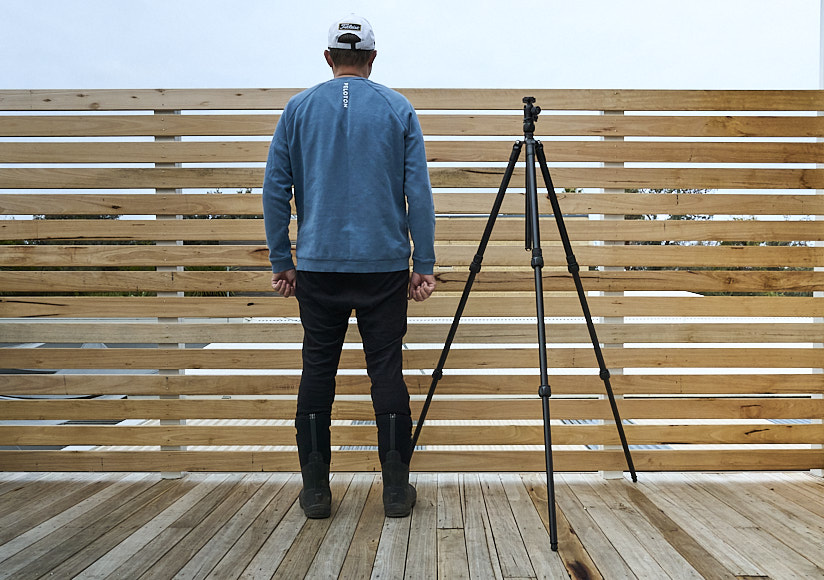
The tripod is high enough for me (6’/183cm) to use without the centre column extended
Tripods this size tend to be heavy, carbon or otherwise. It’s not a lightweight travel tripod designed for photographers looking to keep their weight down; it’s a heavy duty tripod designed with heavy camera gear and stability in mind.
You’re either using this in a studio or in a location where weight isn’t an issue. As an example, if I’m going to photograph the Aurora, I have locations near me where I can park, walk 20 meters, and set up. When I am setting up in those locations, it’s typically when I am more like to want stability due to the risk of high winds.
Relatively to the carbon version, it has a combined weight of 2.4 kg for the legs and head. That puts it about half a kg heavier than the Winston, which has a similar weight rating and height.
Without the column extended and with only three leg sections, it still reaches a respectable 149m (58″). What that means in real terms is the following: As a 6′ (183cm) tall male, my Sony full frame with battery grip sits slightly above eye level without raising the centre column.
The centre column on the tripod can be completely removed, and the design is such that you are able to attach the ball head to the tripod legs without the column. This offers some versatility for those who don’t want to use the centre column or for using the tripod close to the ground.
It’s also possible to reverse the column direction so the camera is sitting under the tripod, something which is important for macro work. With the height of the tripod, it may seem like a no-brainer to remove the column, but remember that “up and down” adjustments are sometimes easier with a single column than three individual legs, so I’d recommend leaving it on.
Leg Locks & Joints
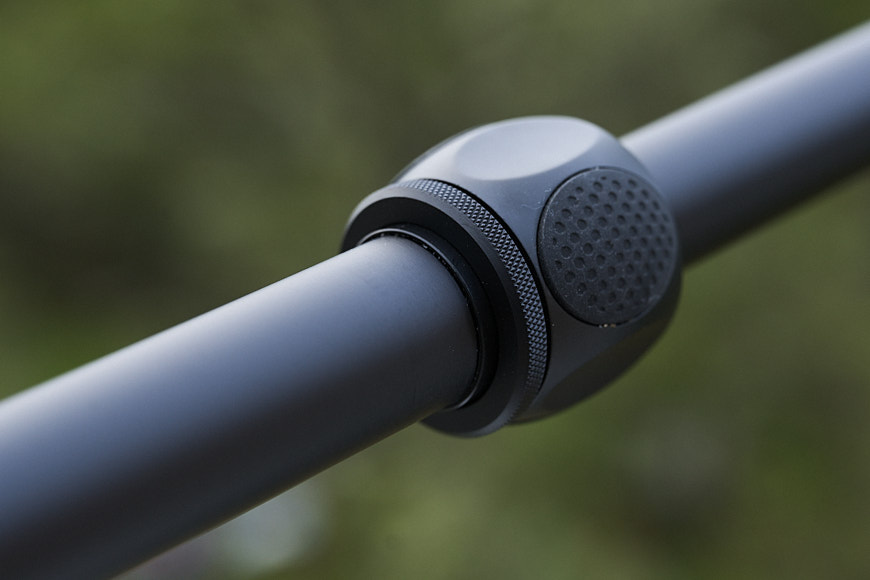
The quality of the leg locks looks amazing; it reminds me a little of the Canon RF lenses.
As with the rest of the tripod, the legs and joints are premium quality and well thought out. The legs follow the traditional twist lock design, which is my preference over the latches. There are only two leg locks (3 sections as opposed to 4) to reach full height.
This has the benefit does make setup a little easier but obviously comes at the expense of size, in particular when you fold the tripod. Given this isn’t a travel tripod, this shouldn’t be a big issue.
The twist locks on the legs are easy to manipulate, large enough to get a full grip. Unlocking and locking is firm but easy. You will need to be a little careful with the leg locks when you loosen the twist lock, you occasionally find the leg untwisting, so make sure you tighten these properly. This is as a result of the legs being removable for use as a monopod or boom.
The tripod uses a design where the legs fold over the ball head for storage. When opening the tripod, you will need to manually lock the leg angle. I would have preferred this to be a spring-loaded locking mechanism, but it’s not a show-stopper.
I would also recommend double-checking when opening and closing to be on the safe side. The legs offer multiple angles making it suitable for those occasions where you want the camera close to the ground or a little more stability.
As mentioned in the construction area, 3 Legged Thing offers multiple footwear options if you aren’t happy with the standard rubber option.
Ball Head
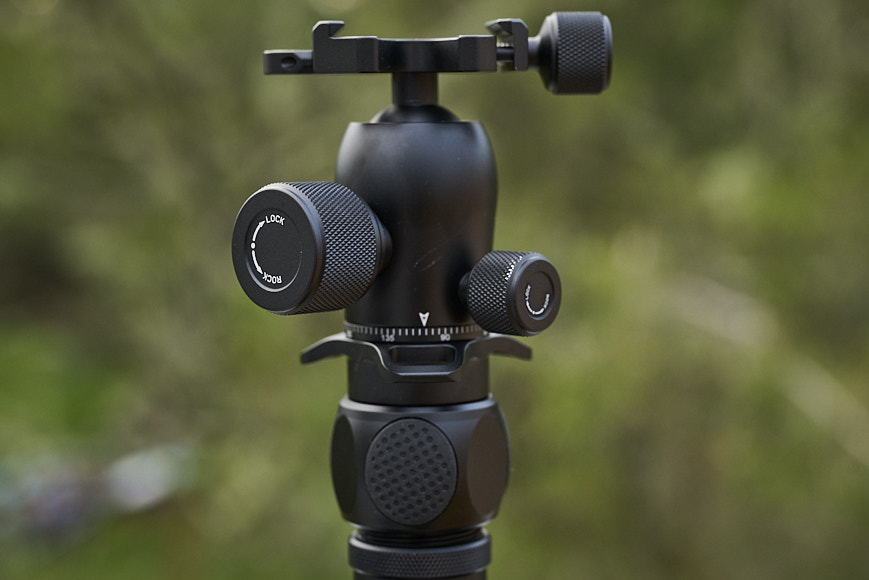
The AirHed Pro is an established model in the 3 Legged Thing lineup, and matches the legs both in style and functionality.
The ball head, or AirHed Pro as 3 Legged Thing calls it, is a heavy-duty ball head capable of holding 40 kgs. It seems like a little bit of an oxymoron using the term “air” with any ball head that carries 40kg / 88lb, but 3 Legged Thing has done well to keep the weight down.
The AirHed Pro includes a twist clamp design with an Arca-compatible plate. They do offer a lever clamp option, but it doesn’t seem like this is offered in the kit. You may want to purchase this separately with the legs only if this is your preference.
The Arca-compatible plate works well. It has a rubber layer to grip the camera when tightened and two retaining screws to provide additional security if the twist clamp loosens. I personally prefer full-size plates, but 3 Legged Things offering here is in line with most manufacturers.
The tool provided by 3 Legged Thing fits the bottom of the plate, ensuring you can securely attach it to the camera. In conjunction with the level on the legs, the ball head contains another spirit level.
The friction knob is smooth for adjustments, but no clutch is provided. In use, this didn’t seem like a big constraint. This is no identifiable creep once the friction knob is tightened, even with heavier lenses like my 100-400mm.
A panorama option is provided for quick horizontal adjustments and offers measurements for those looking to do stitching of photos. I don’t do much stitching, but it’s a handy option.
As expected, the AirHed offers a portrait option with the ball head dropping into a slot to convert the camera from landscape to portrait. I like to call this the Instagram slot, given the popularity of 4:5 portrait ratio on the platform.
How I Tested the 3 Legged Thing Charles 2.0
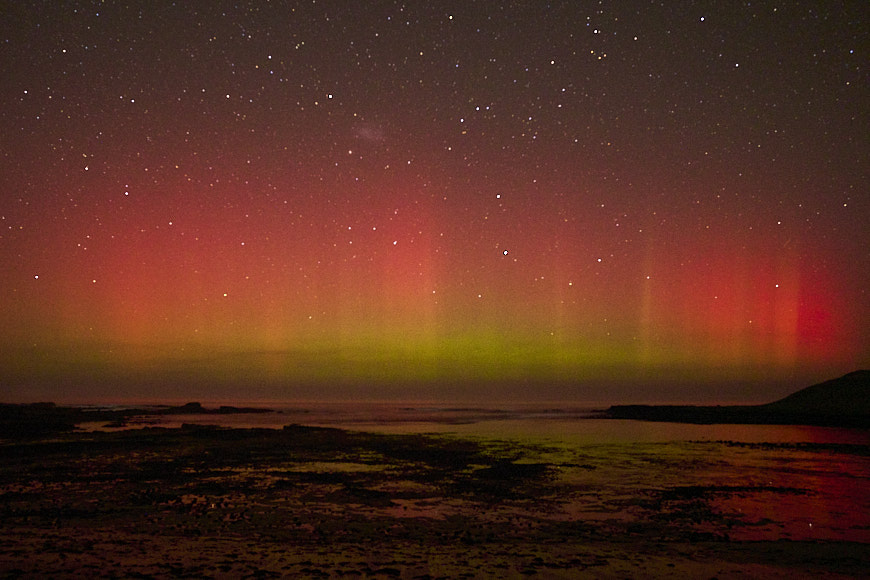
This Aurora Australis was taken with a Sony A7riii, 24mm f/1.4 GM on the 3 Legged Thing Charles 2.0
The tripod was tested extensively on location at Phillip Island, Australia. We are fortunate enough to be about a hundred miles from the nearest major city, making it an ideal location for Astro and Aurora Australis (or Southern Lights) photography.
The Aurora Australis is the southern hemisphere version of the Aurora Borealis. It also contains yellow, red, pink, purple and green. Depending on the KP index and how far south you are, it may not be visible to the naked eye, but it shows up in long exposures.
Many of the key Aurora and landscape photography locations on Phillip Island are less than 10 minutes from where I live. Whilst testing, we had a fairly good Aurora appearance, and the Charles 2.0 performed admirably.
On occasion, I tested with the centre column fully extended; there were absolutely no concerns with stability, even with heavier lens. It’s obviously not a recommended setup, but the weight and stability of the tripod makes this fairly safe with the exception of windy conditions.
Alternatives
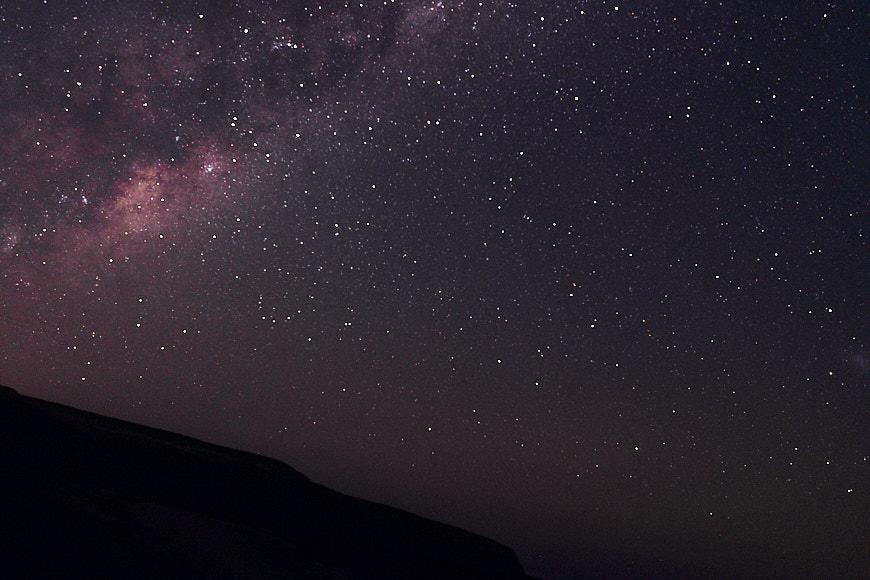
Astro/landscape and portrait photographers alike will be happy with the versatility of the Charles 2.0
There simply aren’t a lot of competitors to the 3 Legged Thing Charles 2.0. Heavy-duty carbon fibre options with the same build quality are more than double the price whilst not offering the same capability in terms of versatility.
Aluminium options just don’t have the capacity to compete. The maximum most aluminium tripods go to is 40lb’s whereas the Charles handles more than 40kg (88lb).
As a result, The Charles 2.0 stands a little bit in a class of its own. A $400 tripod combo that handles 40kg (88lb) comfortably.
Just for reference, here are a couple of other 3 Legged Thing tripods we’ve reviewed on Shotkit:
Value for Money

The high construction quality is surprising, given the price range of the Charles 2.0.
With a recommended retail of $400, including the ball head or $300 for just the legs, the 3 Legged Thing Charles 2.0 is extremely well priced given the load capacity, quality and construction. You won’t find any tripods in that price range with a load capacity of 40kg (88lb).
If you are prepared to spend a $100 more, the Winston will provide you with similar specs, carbon fibre legs and about 400 grams of weight savings. Aside from the Winston, which is also 3 Legged Thing, there simply aren’t any competitors in the same price range.
The closest competitor is Leofoto which is carbon fibre, $200 more than the Charles 2.0 and has no centre column. Given the quality of the tripod and ball head, that’s actually a great achievement by 3 Legged Thing, because they’ve actually managed to deliver a budget-priced heavy-duty tripod with premium quality.
FAQ’s
Is the tripod offered as legs only?
Yes, 3 Legged Thing offers an option with and without the AirHed Pro.
Does it come standard with a camera plate?
Yes, if you purchase the combo with the ball head, it is provided with a camera plate
Are the spikes provided with the tripod?
No, these are an optional extra
Are these suited to sea water?
Yes, but the carbon fibre Winston may be better as carbon fibre is more resistant to salt water. If you get the Charles, I would recommend cleaning it after exposing it to any salt water
3 Legged Thing Charles 2.0 Review | Conclusion
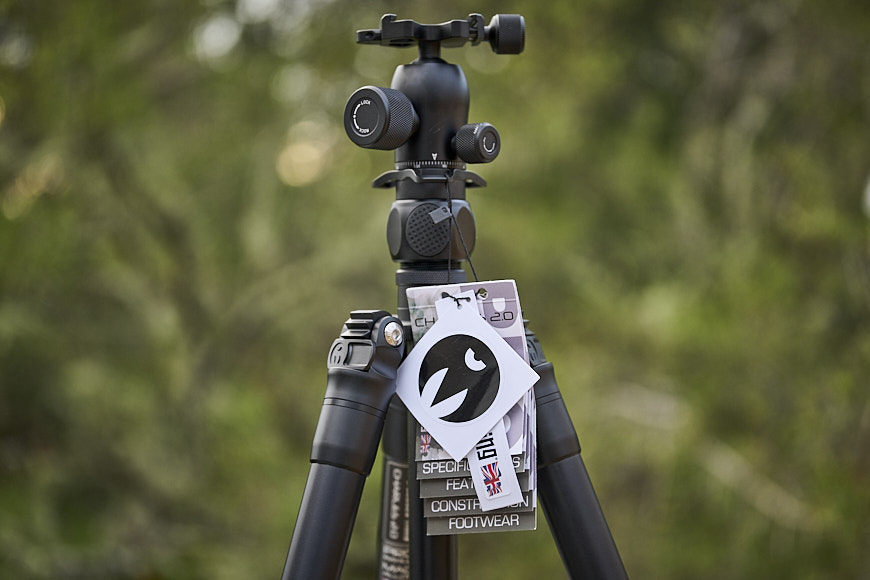
A “complete” landscape or portrait photographers package. This isn’t much more to add.
(Sum up your thoughts on the bag in a few final paragraphs and whether you’ll be keeping/using it or not in the future.)
This is my first outing with a 3 Legged Thing, having tested many other tripod manufacturers, including Gitzo, Manfrotto, Benro, and Sirui.
The Charles 2.0 caught me a little off guard. When the Charles 2.0 first arrived, the non-carbon fibre construction created a flawed initial impression that this was your typical budget-orientated offering, but that couldn’t be further from the truth. I walk away impressed and an instant fan of 3 Legged Thing. This will become a permanent fixture for my astro/landscape and aurora photography.
In truth, it may be a budget price, but this tripod is actually an amazing premium-quality tripod and one of the best landscape tripods I’ve used to date. This is also the perfect entry-level tripod for novices to get into landscape or portrait photography without breaking the bank.
It’s really hard to put forward negatives for this tripod because it is designed to be a little more niche than many travel tripods. That in itself may be a negative, but the pricing makes it accessible to a broad audience, and this fills a gap on the heavier capacity end.
If you’re someone who does a lot of landscape or astrophotography, I would highly recommend you look at the Charles 2.0.

Strong, rugged and stable - everything you need in a great-looking design.





